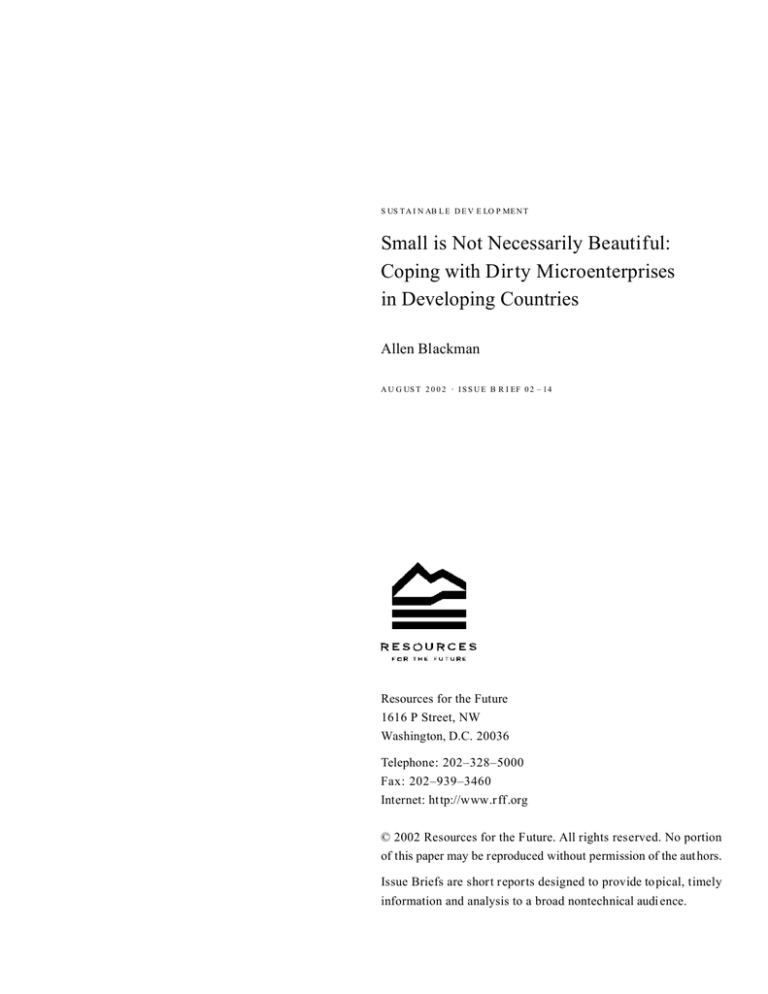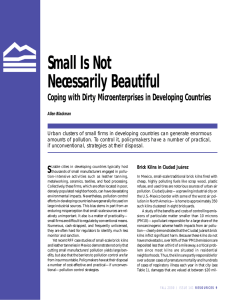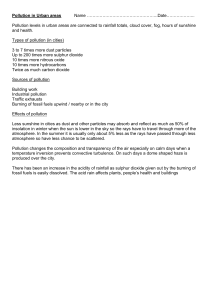S mall is Not Necessarily Bea u tifu l :
advertisement

S US T A I N AB L E D E V E LO P ME N T Small is Not Necessarily Beautiful: Coping with Dir ty Microenterprises in Developing Countries Allen Blackman A U G US T 2 0 0 2 · I S S U E B R I EF 0 2 – 14 Resources for the Future 1616 P Street, NW Washington, D.C. 20036 Telephone: 202–328–5000 Fax: 202–939–3460 Internet: ht tp://www.r ff.org © 2002 Resources for the Future. All rights rese rv ed. No portion of this paper may be reproduced without permission of the aut hors. Issue Briefs are shor t reports designed to provide to pical, timely information and analysis to a broad nontechnical audi ence. Urban clusters of small firms in developing countries can generate enormous amounts of pollution. To control it, policymakers have a number of practical, if unconventional, strategies at their disposal. L arge cities in developing countries typically host thousands of microenterprises that engage in pollution-intensive activities such as leather tanning, metalworking, ceram ic s , textiles, and food processing. Collecti vely, these firms, which are often located in poor, densely po pulated neighborhoods, can have devastating environmental impacts. Nevertheless, pollution control ef forts in developing countries have generally focused on big industrial sources. This bias stems from an enduring misperception that small-scale sources are relati vely unimportant and from the difficulty of applying conventional regulator y tools to micro ente rp rises. Many small f irms are unlicensed and unregulated and therefore difficult to identify or sanction. Also, microenterprises are costly to monitor because they are so numerous. Finally, such firms usually sustain the poorest of the poor and may appear to both regulators and the public as inappropriate targets for regulation. Yet recent RFF case studies of small-scale brick kilns and leather tanneries in Mexico demon- strate not only that cutting microenterprise po llution yields large benefits, but also that the barriers to pollution control are far from insurmountable. Policy makers have at their disposal a number of cost-effective and practical—if unconventional—pollution control strategies. Brick Kilns in Ciudad Juárez In Mexico, small-scale traditional brick kilns fired with cheap highly polluting fuels like scrap wood, plastic refuse and used tires are a notorious source of urban air pollution. Ciudad Juárez— a sprawling industrial city on the U.S.-Mexico border with some of the worst air pollution in North America—is home to approximately 350 such kilns clustered in eight brickyards. A study of the benefits and costs of controlling emissions of particulate matter smaller than 10 microns (PM10)—a pollutant responsible for a large share of the non-carc inogenic adverse health impacts from air pollution—clearly demonstrates that the Ciudad Juárez’s brick kilns inflict si gn ificant harm. Because these kilns do not have smoke stacks, over 90% of their PM10 emissions are deposited less than a third of a mile away, a critical problem since most kilns are situated in res idential neighborhoods. Par tly as a result, the kilns are responsible for over a dozen cases of premature mortality and hundreds of cases of respiratory illness each year (see the Ta ble on page 3), impacts that are valued at between $20 million to $150 million. By contrast, the annual costs of pollution control programs that would virtu al ly eliminate these impacts are estimated at less than $300,000. Although brick kilns are widely reco gn ized to be a leading source of air pollution in C i u da d Juárez and its sister city, El Paso, Texas, a number of factors make it politically difficult to require brickmakers to bear the full costs of pollution control: brickmaking pro vi d es over 2,000 jobs, most brickmakers are impoverished (profits per kiln average $100 per month), and most belong to a trade association or other local organization that can lobby against pollution control ef for ts. 2 Resources for the Future ·Issue Brief Despite these obstacles, ef for ts to control brick kiln emissions had considerable success in the early 1990s. In 1989, the municipal env ironmental authority initiated a “clean technology” project aimed at substituting propane for dirty fuels. The nex t year, the propane initiative was handed off to the Federación Mexicana de Asociaciones Privadas de Salud y Desarrollo Comuni tario (FEMAP), a private non-profit social services organization. FEMAP was able to attract considerable funding and participants from both sides of the border including local propane companies, uni versities and Los Alamos National Laborator y. Leaders of the propane initiative used a number of carrots and sticks. First, they subsidized various costs associated with adopting propane. Mexican propane companies pr ovided most of the requisite equipment and training free of charge. To make propane more attractive despite the fact that it was more expensive than traditio nal fuels, engineers at Los Alamos National Laboratories designed new energy-efficient kilns. Unfortunately these kilns proved pro hibitively expensive and complicated. Second, the initiative’s le aders wor ked to ratchet up pres sures on brickmakers to adopt propane. Most importantly, they convinced brickmaker trade unions in several brickyards to prohibit their members from using dirty fuels. Also the city government banned the use of particularly dirty fuels and set up a telephone hotline to register complaints about brickmakers violating TABLE 1 ANNUAL HEALTH EFFECTS FROM UNCONTROLLED BRICK KILN PM10 EMISSIONS ( N U M B E R O F C A S E S ; M E A N V A L U E S A N D 9 5 % C O N F I D E N C E I N T E R VA L S ) Health Endpoint Ciudad Juárez El Paso Low Mean High Low Mean High 2.6 14.5 33.4 0.5 2.8 6.4 Respiratory hospital admissio ns 0 266 807 0 38 116 Emergency room visits 0 617 1,708 0 89 246 Work loss days 0 3,267 9,690 90 471 1,397 Respiratory symptom days 93,280 387,400 814,800 15,650 64,990 13 6,700 Restricted activity days 3,737 142,400 395,900 539 20,530 57,070 159 43,500 112,300 23 6,272 16,190 3 1,652 4,560 0 179 495 Childrens’ chronic cough 0 1,908 4,993 0 207 542 97 264 0 16 44 Mor tality Ast hma attacks Childrens’ chronic bronchitis Adult bron ch itis cases 1 Source: Bl a ck man, Newbold, Shih, and Cook, 2000 Small is Not Necessarily Beautiful: Coping with Dirty Microenterprises in Developing Countries 3 the ban. Enforcement teams with the power to jail and fine violators were dispatched in response to complaints. Third, FEMAP initiated an educational campaign to raise brickmakers’ awareness of the health hazards associated with dirty fuels. Finally, project leaders tried to reduce competitive pressures for brickmakers to use cheap dirty fuels by organizing a boycott of bricks fired with dir ty fuels. However, the boycott was quickly undone by rampant cheating. By the end of 1993, over half of the Ciudad Juárez brickmakers were using propane. Unfortunately, this success pr oved short-lived. In the early 1990s, as part of a nationwide economic liberalization program, the fe deral gover nment was phasing out long-standing propane subsides. As propane prices continued to rise in 1994, propane users switched back to dirty fuels. By 1995, only a handful of brickmakers were still using propane. However, the propane initiative has had some lasting impacts: local organizations and city officials continue to enforce a ban on particularly dirty fuels such as tires and plastics. Leather Tanneries in León The city of León in north-central Mexico produces about two-thirds of the country’s leather. Of the 1,200 tanneries in the city, about half employ fewer than 20 workers. Virtually all of León’s tanneries dump untreated toxic effluents directly into municipal sewers where they flow untreated into the Turbio River. The resulting pollution has contaminated ground water, destr oyed irrigated agricultural land, and caused serious health problems. Regulations governing water pollution have been on the books for decades, but most are simply not enforced. By all accounts, the main reason is that, as one of the city’s principal employers, tanners have considerable political power. Concer ted ef for ts to control pollution from tanneries in León began in 1986. Tannery representatives signed a convenio (voluntary agreement) with r egulators in which they agreed to comply with written regulations within four years. But when it became apparent in 1990 that the tanners had not taken any action, they were given a second four-year grace period. At the end of t his second grace period, tanneries still had made no progress, so they were granted yet another gr ace period. This cycle has continued until today. In addition to the succession of convenios, there has also been an attempt to control pollution by relocating the tanneries. In the early 1990s, the city built the infrastructure for a tannery industrial park with a common wastewater treat me nt f acility. Tann ers were required to purchase land and build new facilities in the park. In consideration, they were to be provided with subsidized loans and tax credits. However, tanners ultimately refused to foot these costs, and today the industrial park stands empty. Perhaps the most successful means of controlling tanner y emission in León has been the largely voluntary adoption of clean tanning technologies, including sedimentation tanks that allow particulate matter to settle out of waste streams; low-chemical tanning recipes; enzymes that substit ute for sulfur compounds used to rid hides of hair; recycling tanning baths; and chrome recovery. Estimates of the percentage of tann eries using these technologies range from 90% for sedi me ntation tanks w hich are required by law (this law appears to be enforced), to less 5% for chrome recovery. In view of the proven political and economic constra ints on relocation and conventional regulation, clean technologies currently represent the best hope for controlling tannery pollution. To 4 Resources for the Future ·Issue Brief assess the barriers to and incentives for adoption of clean technologies, a team of researchers from RFF and the University of Guanjuato in Mexico recently administered a detailed survey to about 170 tanneries. Preliminary analysis of the survey data suggests that for most technologies, firm size is not determinative: small tanneries are just as likely to adopt as large ones. Rather, access to information about the technology as well as the education of tanner y managers appears to be critical. Many of clean technologies are simply not well-known or well-understood by tanne rs . Surprisingly, key sources of information and assistance are private sector entities, including chemical supply companies, fellow tanners, and the tannery trade associations. Another finding is that adop te rs of cer tain technologies tend to be spatially clustered suggesting that demonstration effects are important. In the case of one technology—sedimentation tanks—laws requiring installation are c learly driving adoption. Finally, even though most of these technologies lower materials costs (and sometimes labor costs), several entail significant set-up which act as a significant barrier to adoption. Lessons Learned Political constraints. In both Ciudad Juárez and León, city regulator y authorities have been able to en force regulations that impose minimal costs on polluters—for example in León, they have compelled tanneries to install sedimentation tanks—but they have not been able to consistently enforce more burdensome regulations. A key reason is that brickmakers in Ciudad Juárez and tanners in León are numerous and w ell-organized and, as a result, have the power to block enforcement. In general, when dealing with severe pollution problems created by microenterprises, political considerations are likely to be quite important, if not paramount. S evere pollution problems arise when small polluters are numerous, and when polluters are numerous, they are bound to have political power. Consequently, successful policies will need to accommodate polluters’ con ce rn s about the costs of pollution control by offering subsidies and inducements. Informal regulation. The case studies suggest that so-called “informal” regulatio n—pressure generated by private sector actors that have day-to-day contract with polluters—is probably the most important ingredient of a successful microetnerprise pollution control program. In C iudad Juárez, brickmakers trade unions played a critical role in promoting propane by enforcing pro hibitions on the use of traditio nal fuels in some brickyards. Also, citizen complaints facilitated enforce me nt of a municipal ban on dirty fuels. In León, pollution control ef for ts have been stymied by the a bsence of such private sector pressure. There are a number of explanations for the lack of informal regulation in León. Most households in the city depend on the leather industry for their livelihood so it is difficult to generate public support for measures that raise tanners’ production costs. Also, tannery emissions are less noticeable than those of brick kilns, and their health and environ me ntal impacts are less immediate. Hence, informal regulation would seem to be easier to generate when polluters are not the mainstay of the local economy and when emissions are easy to detect and have immediate adverse health impacts. Clean technological change. Given the barriers to regulating micro ente rp rises by conventional means, c lean technological change represents a particularly pr omising pollution control strategy. In both cities, technical assistance spurred clean technology ado ption and, in Ciudad Juárez, a campaign to educate brickmakers about the health impacts of dirty fuels also appears to have had Small is Not Necessarily Beautiful: Coping with Dirty Microenterprises in Developing Countries 5 some impact. Surprisingly, both case studies suggest that private-sector organizations, such as the equipment suppliers and the trade associations can be the principal pur veyors of technical information, an encouraging prospect given chronic constraints on resources available for public sector initiatives. The Ciudad Juárez case study also demonstrates that clean technologies need not be “winwin” propositions, that is, they need not reduce production costs as well as polluting emissions. The majority of brickmakers adopted propane and continued to use it for over a year even though it significan tly increased production costs. Part of the explanation may have to do with the interplay between competition and informal r egulation. The market for bricks is highly competitive and, as a result, brickmakers that use high-cost c lean fuels are liable to be undercut by competitors using dirty fuels. Thus, initially competition in the market for bricks discouraged adoption. But o nce diffusion has progressed past a cer tain stage, competition appears to have worked in favor of adoption because t hose who had adopted have an incentive to ensure that their competitors adopt as well. Moreover, ado pters generally had some leverage over competitors who were neighbors and/or fellow union members. As a result, once an initial c adre of brickmakers adopted, neighbors and fellow union members quic kly followed suit. This suggests that if a critical mass of micro ente rp rises can be convinced by hook or crook to adopt a cost-increasing clean technology, eventually diffusion can become self-perpetuating. Finally, the failure of efforts to successfully diffuse costly complicated energy-efficient kilns in Ciudad Juárez demonstrates the well-established principal that that in developing countries, new technologies must be appropriate, that is both af fordable and consist ent with existing levels of technology. The promise of private-sector-led environmental initiatives. The r elati vely successful Ciudad Juárez experience suggests that private-sector-led initiatives hold considerable promise as a means of addressing microente rp rise po llution problems. They would seem to enjoy a number of advantages over state-run programs. F irst, the willingness of the majority of the Ciudad Juárez brickmakers to cooperate with the project suggests that private-sector-led initiatives may be best suited to engage unlicensed f irms that by their nature are bound to be wary of sustained contact with regulator y authorities. Second, the public enthusiasm that the propane initiative generated suggests that private-sector-led projects may be able to draw more freely on public sympathy for environmentalism than top-down bureaucratic initiatives. And finally, the projects’ success at consensus building among a diverse set of stakeholders suggests that private-sector-led-initiatives may be better able to sidestep the politics and bure aucracy that often plague public-sector-led initiatives. By contrast, the León ef for ts to establish convenios have been rife with such problems. The qualified success of the propane initiative however, does not imply that small-scale pollution problems are best left to private sector organizers. In all likelihood, the propane initiative would not have had as much success without unusually strong public sector suppor t. Boycotts. In Ciudad Juárez, the attempt to organize a boycott of the brickmakers still using dir ty fuels was an utter failure. Buyers simply cont inued to buy bricks from whoever was selling at the best price. This experience suggests that in most cases, contravening market forces—especially in informal or lightly regulated mar kets—simply does not work. Monitoring is too difficult and cheating is too easy. 6 Resources for the Future ·Issue Brief Further Readings A. Bl a ck man, S. Newbold, J.-S. Shih and J. Cook. 2000. “The Benefits and Costs of Informal Sector Pollution Control: Traditio nal Mexican Brick Kilns” Resources for the Future Discussion Paper No. 00-46 (w ww.r ff .org/CFDOCS/disc_papers/PDF_files/0046.pdf, accessed July 22, 2002). A. Bl a ck man. 2000. “Informal Sector Pollution Control: What Policy Options Do We Have?” World Develop ment. Vol. 28, No. 12. Forthcoming. A. Bla ck man and G. J. Bannist er. 1998. “Community Pressure and Clean Technology in the Informal Sector: An Eco nometric Analysis of the Adoption of Propane by Traditio nal Mexican Brickmakers.” Journal of Envi ronmental Economics and Management. Vol. 35, No. 1, 1- 21 . Allen Bl a ck man is a RFF fellow Small is Not Necessarily Beautiful: Coping with Dirty Microenterprises in Developing Countries 7







